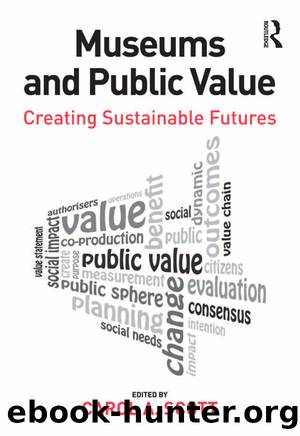Museums and Public Value by Scott Carol A.;

Author:Scott, Carol A.;
Language: eng
Format: epub
Publisher: Taylor & Francis Group
Published: 2013-09-15T00:00:00+00:00
Figure 7.1 Former sugar warehouse at West India Quay, now home to Museum of London Docklands
WORKING WITH THE COMMUNITY
To set the agenda effectively it was agreed that the museum should set up a Consultative Group, crucially including black Londoners of African-Caribbean heritage, who would work with the museum to develop an historical narrative that challenged existing historiographies around the slave trade and, through a combination of their association with the museum and personal life experiences, provide an authentic and authoritative voice amongst the many that would be heard in 2007. The Consultative Group comprised individuals who were engaged in relevant work in London and most were already known to the museum through earlier encounters. These included, for example, Harrington Cumberbatch,5 who worked locally with black Londoners with mental health problems, Burt Caesar, a Kittitian who located his surname in the museumâs slave papers from the Mills plantation on St Kitts, and Hakim Adi, a founder member of the Black and Asian Studies Association.6 The most important term of reference for the Group was that it was an equitable partnership. It had an equal voice with the museum on steering all aspects of the gallery development. One example of the work of the Group was to challenge the simplistic notion of abolition that was being repeatedly played out by many at the time. For example, the Wilberforce Museum in Hull was planning to re-open in 2007 following a multi-million pound refurbishment with a focus on the work of William Wilberforce7 who was portrayed as a hero of the abolition movement and the bicentenary. Hull is in the constituency of John Prescott who was Deputy Prime Minister at that time and who was therefore able to foreground the Wilberforce story within political and media circles. The Museum of London Docklands could challenge this interpretation, presenting the more nuanced story of abolition. It could demonstrate that Wilberforce was not the most important agency behind the abolition of the slave trade in the views of many, and that this concept was offensive to many black Londoners. Attention should be drawn, for example, to the actions of enslaved Africans in resisting slavery which eventually made the slave system untenable and to the role of women in eighteenth-century London who formed a pressure group by boycotting the purchase of sugar grown on slave plantations.
The validity of the museumâs approach to create the LSS gallery with its Consultative Group was recognized by the Heritage Lottery Fund, who awarded one of its largest grants at that time. The challenge the museum now faced was how to translate the goodwill, expertise, life experiences and passion of the Consultative Group into a gallery that would be valuable to all visitors, regardless of age, creed or colour. The question was how to create an historical narrative that challenged preconceptions that largely perpetuated the notion of the enslaved as passive âchattelsâ who were subjugated, and subsequently liberated, by their white oppressors turned emancipators. As important, perhaps, was the aim to create an
Download
This site does not store any files on its server. We only index and link to content provided by other sites. Please contact the content providers to delete copyright contents if any and email us, we'll remove relevant links or contents immediately.
Technical Art History by Jehane Ragai(406)
Art, Science, and the Natural World in the Ancient Mediterranean, 300 BC to AD 100 by JOSHUA J. THOMAS(384)
Graphic Culture by Lerner Jillian;(373)
The Slavic Myths by Noah Charney(330)
Pollak's Arm by Hans von Trotha(305)
Treasuring the Gaze by Hanneke Grootenboer(305)
Simply Artificial Intelligence by Dorling Kindersley(302)
The Art of Portrait Drawing by Cuong i(295)
Drawing Landscapes by Barrington Barber(290)
Drawing for the Soul by Zoë Ingram(289)
The Art of Painting Sea Life in Watercolor by Maury Aaseng Hailey E. Herrera Louise De Masi and Ronald Pratt(276)
Sketchbook Confidential: Secrets from the private sketches of over 40 master artists by Editors of North Light Books(272)
Portrait of a Woman by Bridget Quinn(261)
Preparing Dinosaurs by Wylie Caitlin Donahue;(255)
A text-book of the history of painting by Van Dyke John Charles 1856-1932(254)
Anatomy for the Artist by Jennifer Crouch(252)
Mountain Manâs Field Guide to Grammar by Gary Spina(249)
Egyptian art by Jean Capart(246)
Botanical Illustration by Valerie Price(245)
